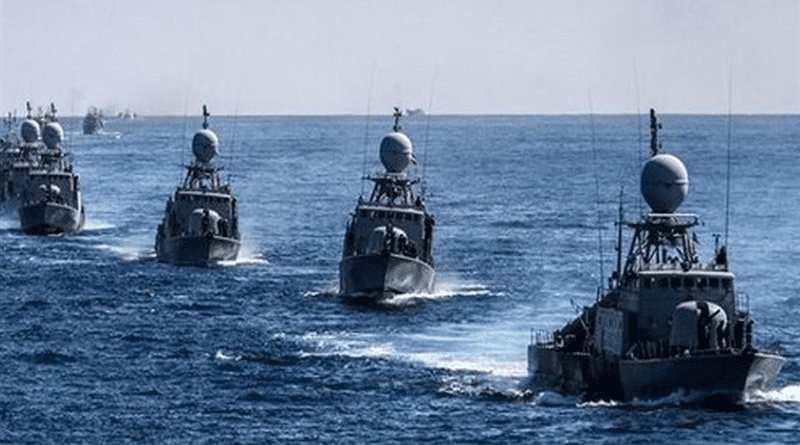Iran’s Regional Influence And Military Muscle: Growing Military Capabilities And Role As Regional Power – OpEd
By Azyan Afzal
The Islamic Republic of Iran, situated in West Asia, is the sixth-largest country in Asia and the second-largest in West Asia, covering a land area of approximately 1,648,195 square kilometres. With a total population of 89,705,600, Iran shares extensive borders with various neighbouring countries. To the west, it shares a border stretching over 1,400 kilometres with Iraq, while to the northwest lies Turkey. In the east, Iran’s border spans over 900 kilometres with Afghanistan, and to the southeast, over 900 kilometres with Pakistan. To the north, Iran shares borders with Azerbaijan, Armenia, the Caspian Sea, and Turkmenistan, while to the south, it is bounded by the Persian Gulf and the Gulf of Oman.
Iran’s strategic importance in the region is derived from its economic, geopolitical, and cultural influence, as well as its military strength and regional alliances. This makes Iran a crucial player in the Middle Eastern region.
Military Strength and Strategic Importance:
Iran’s military doctrine, which combines ideological and technical elements, underscores its commitment to achieving political goals through military means. Iran defense budget for 2022 was 6.85 billion USD, With a total military personnel count of 1,180,000, including 610,000 active military personnel and 350,000 reserves, Iran possesses a formidable force. Its air force, consisting of 42,000 personnel and 551 aircraft, including 205 combat aircraft, 186 fighter aircraft, and 19 multi-role aircraft, further solidifies its military might. Additionally, Iran’s substantial UAV count, exceeding 2,000, enhances its reconnaissance and strategic capabilities.
The Iranian navy, with 18,500 personnel and a fleet of 101 vessels, including 07 frigates, 19 submarines, and 942 merchant marines, ensures Iran’s presence and influence in crucial waterways such as the Persian Gulf and the Gulf of Oman. Despite these considerable military capabilities, Iran’s power projection remains incomplete, primarily due to the asymmetrical nature of modern warfare.
Forward Defense Strategy and Proxy Warfare:
However, these military capabilities are insufficient for Iran to claim regional power. To compensate, Iran has adopted a strategy of Forward Defense, supporting friendly militias and insurgent groups across the Middle East. The Quds Force, a part of the IRGC (Islamic Revolutionary Guard Corps), trains and equips such proxies to achieve Iran’s goals.
Hezbollah, the oldest and strongest political non-state actor in Lebanon, boasts approximately 45,000 fighters. In Iraq, the Badr Organization, formed in 1982, has 20,000 fighters.
Iran’s partnership with Houthi rebels, a Zaidi Shia Muslim minority in Yemen, allows Iran to strike deep into Saudi Arabia, its Sunni rival in the region. The Houthis have posed challenges for the U.S. Navy in the Red Sea and have not supported Israel in the Israel-Palestine conflict.
Through these proxies, Iran gains security benefits, including assistance in countering foreign intelligence threats, intelligence sharing, and counter-terrorism efforts.
Iran supports Hezbollah in Lebanon, the Badr Organization in Iraq, and the Houthis in Yemen to project its power in the region, deter Israel and the United States, and secure a more than 1000-kilometer-long land corridor connecting Iran to the Mediterranean Sea.
Iran’s Contemporary Military Confrontations and Retaliatory Actions:
Iran’s military capabilities were tested when Israeli F-35 jets carried out an airstrike on an Iranian consulate building in Damascus, Syria, resulting in the fatalities of several high-ranking IRGC officials. In retaliation, Iran launched a significant operation against Israeli territory on April 13th and 14th, deploying 170 drones, 30 cruise missiles, and 120 ballistic missiles. However, the majority of Iranian missiles and attack drones were intercepted by the Israeli Defense Forces (IDF), along with British and US forces stationed in the region. Approximately 7 missiles struck the Nevatim airbase in Southern Israel.
Additionally, on January 18, 2024, Pakistan launched an operation called “Marg Bar Sarmachar” meaning “death to insurgents” effectively striking hideouts inside Iran used by terrorists responsible for recent attacks in Pakistan. The precision strikes, carried out using killer drones, rockets, loitering munitions, and stand-off weapons, demonstrated the professionalism of Pakistan’s armed forces and the lack of preparedness of Iran’s armed forces.
Economic Challenges and International Sanctions:
Despite its military ambitions, Iran’s economy grapples with serious challenges, exacerbated by international sanctions and a struggling currency. With one USD equal to 42,075.00 Iranian Rials, Iran’s economy faces significant hurdles in achieving sustainable growth and development.
Iran has been labelled as a rogue and irresponsible state by the West, posing a serious threat to world peace. Its nuclear program remains under sanctions by the (P5+1) 5 permanent member of United Nation Security Council (UNSC) which includes US,UK, France ,China, Russia and Germany, in the 2015 Joint Comprehensive Plan of Action (JCPOA) agreement.
Conclusion:
In conclusion, Iran ranks 14th out of 145 countries in the Global Firepower Index in terms of military strength. However, its conventional power is insufficient and dependent on outdated weapons, making it ineligible for regional power status. Iran is a challenger in the region, challenging Saudi Arabia and the United Arab Emirates. To achieve regional power status, and to overcome these challenges Iran needs to focus on economic growth through cross-border trades and investments, heavy investment in research and development, and modernization of its weapons and military equipment. Only by addressing its economic vulnerabilities can Iran hope to achieve its aspirations of regional power and secure its position as a key player in the Middle East.

